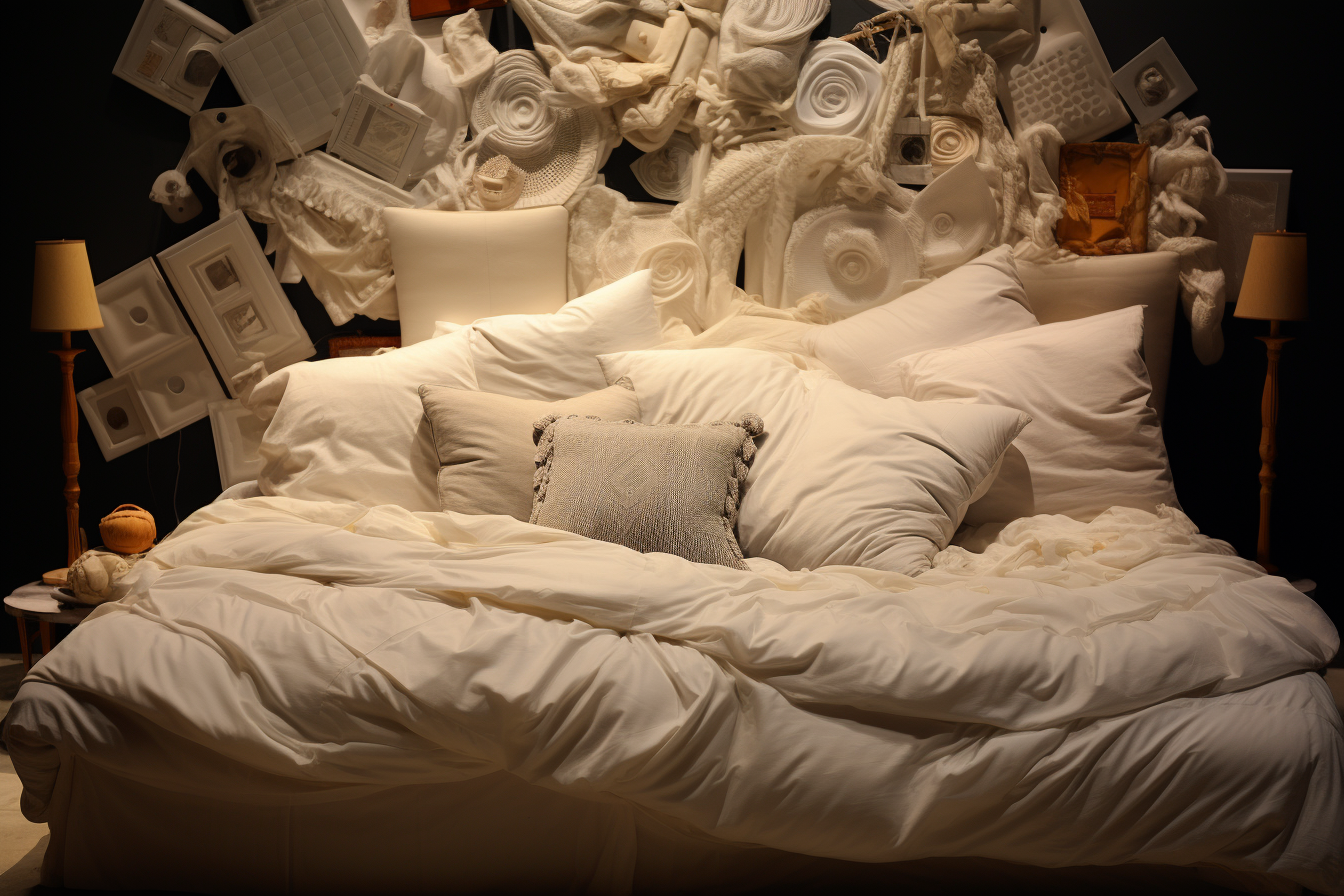With their ultra-luxurious feel against skin, silk pillowcases are beloved for beauty sleep. But special care must be taken when laundering delicate silk to prevent damage. Follow this comprehensive guide to learn the best methods for washing silk pillowcases and bed linens to keep them looking lustrous wash after wash.
We’ll cover the proper techniques for hand washing or machine washing silk, recommended detergent choices, drying guidance, ironing and storing to maintain their sensuous softness. With the right silk washing approach, your bedding keeps its vibrant appearance and indulgent feel.
Table of Contents
ToggleBenefits of Silk Pillowcases
Before washing, let’s review why silk bedding is worth the extra care:
- Extremely soft, lightweight, and exceptionally smooth texture.
- Helps retain moisture and natural skin oils.
- Minimizes tangles, frizz and bedhead by gently sliding against hair.
- Allows skin to softly glide against the surface.
- Provides cooling in summer yet warmth in winter.
- Hypoallergenic and repels dust mites and allergens naturally.
- Highly durable and withstands regular use when cared for properly.
Understanding silk’s advantages makes protecting it during washing important.
Pre-Treating Silk Pillowcases Before Washing
Before laundering, inspect and pre-treat any soiled silk pillowcases:
- Check for make-up, hair product stains, body oils or perspiration that may need spot treating before washing.
- For liquid stains, dab the spot gently with a lint-free cloth, like microfiber, to absorb excess. Avoid rubbing.
- For stubborn spots, use a targeted enzyme-based pre-treatment spray or stick and let sit 5-10 minutes before washing.
- For greasy areas, lightly sprinkle some baking soda or cornstarch over the stain to absorb oils, then brush off before washing.
- Use lukewarm water to rinse out any pre-treatments before washing.
Pre-treatment and inspection allows you to target problem areas efficiently before laundering your silk bedding.
How to Wash Silk Pillowcases by Hand
For most silk items, a gentle hand wash is safest. Follow these steps:
1. Check the Care Label
Refer to the sewn-in care label on your silk pillowcase for specific hand or machine washing guidance.
2. Use a Large Sink or Tub
To move silk freely, use a clean bathtub, large sink or basin. Avoid crowded, vigorous agitation.
3. Prepare a Mild Detergent Solution
Fill with cool water. Mix in a tiny amount of gentle silk detergent, like Eucalan or Soak Wash. Avoid regular detergent.
4. Submerge and Soak
Totally submerge pillowcases in the wash solution. Let soak 5-10 minutes so the detergent penetrates oils and dirt.
5. Agitate Lightly
Swirl and gently press pillowcases against themselves to dislodge soils without harsh scrubbing or twisting silk fabric.
6. Drain and Rinse
Drain the dirty wash water completely. Run lukewarm clean water into basin. Press out suds, drain and repeat.
7. Roll In Towel
Roll pillowcases in a clean towel to gently absorb excess moisture. Avoid wringing or twisting silk when wet.
For best results hand washing silk, use a specialized process tailored to delicately clean without damaging fragile fibers.
Tips for Washing Silk in the Washing Machine
While handwashing is preferred, you can machine wash silk pillowcases if essential. Follow these precautions:
- Place pillowcases in a mesh wash bag for delicates to avoid tearing. This also prevents tangling other items.
- Use the gentle cycle low speed setting. High agitation risks snagging silk threads.
- Wash silk alone – no mixed loads. Zip all zippers, hooks and ties first.
- Use cold water only. Hot water causes irreversible damage to silk.
- Select a detergent formulated specifically for silks. Avoid regular detergents.
- Opt for extra rinse cycles to fully remove all soap residue which can yellow silk over time.
With the right gentle settings and detergent, machine washing can effectively refresh silk between hand washes. But take extra care.
Drying Silk Pillowcases and Bedding
Always air dry or flat dry delicate silk items. Follow these guidelines:
Layout Flat
Smooth pillowcases into desired shape on a drying rack or stack of towels. Avoid hanging clips that stress seams.
Air Dry is Best
Let silk dry naturally to prevent heat damage from dryers. Flat indoor drying works for smaller items.
Use Fan
Direct a rotating fan over flat-laid silk to speed evaporation. Avoid direct high heat.
Line Dry Outdoors
Sunlight is ideal for drying silk and removing any residual odors or stains. Lay flat or use clips for sheet corners.
No Machine Drying
Never tumble dry silk or use high heat which causes irreparable creasing, yellowing and breakage.
Take care to dry flat without excessive heat to ensure silk dries into its smooth, soft hand-feel.
Ironing Silk Pillowcases
Silk often needs pressing after washing. Follow these methods:
Steam Setting
Use a low steam setting or “silk” setting on an iron if available. Avoid direct dry iron-to-fabric contact.
Inside Out
Flip pillowcases inside out to iron – less friction and risk of shiny spots from iron sliding on fabric face.
Lightly Dampen
Mist silk lightly with clean water before ironing. The added moisture allows gentler, easier pressing.
Iron Underneath
For creases in slippery silk, lay a cotton cloth over the crease and gently iron underneath, applying pressure to flatten.
Avoid Over-Ironing
Lift and set down iron slowly. Don’t rub iron over silk which can damage fibers.
Take your time with low heat when ironing silk pillowcases. Proper technique keeps the fine fibers safe and the finish glossy.
Storing Silk Pillowcases and Bedding
Use these methods to store silk items between uses:
No Folding
Instead of folding, lay silk flat if possible to avoid crease lines becoming permanent. Or hang on padded hangers if space allows.
Acid-Free Tissue
Separate and layer silk pillowcases and sheets with acid-free tissue paper instead of stacking and folding. This prevents creases.
Breathable Containers
Look for unbleached cotton or linen storage bags and boxes. Avoid moisture trapping plastic tubs.
Cedar Sachets
Place cedar chips or cedar-scented sachets in dresser drawers or storage boxes to deter moths and other pests attracted to silk.
Give silk ample airflow in storage to prevent permanent wrinkling or yellowing over time.
Caring for Silk Comforters and Duvet Covers
Follow these tips to launder silk duvets and quilted bedding:
Washing – Dry clean only to prevent shrinkage unless label states “washable silk” specifically.
Stain Removal – Use an enzyme cleaner and distilled water. Avoid excessive moisture.
Drying – Re-fluff and reshape down or fiberfill after drying. Air tumble dry low if possible.
Storage – Allow silk fills to fully loft before folding. Avoid compression that flattens feathers.
With some adjustments, you can keep silk bedding layers properly cared for and luxurious.
Troubleshooting Silk Laundering Issues
Yellow Staining
Causes: Heat exposure, age, body oils, improper soap
Solutions: Soak in mild oxygen bleach. Use an enzyme detergent and wash more frequently.
Snags and Pulls
Causes: Catching on rough surfaces and buttons, abrasion from improper washing
Solutions: Avoid washing with zippers, hooks and buttons unfastened. Use a mesh bag. Handwash gently.
Wrinkling
Causes: Heat damage, improper folding and storage, insufficient ironing
Solutions: Lower iron heat. Use proper drying methods. Store unfolded with acid-free tissue.
Color Bleeding
Causes: Excessive agitation, water temperature too hot
Solutions: Handwash cold separately. Skip the bleach.
With some minor technique adjustments, you can resolve any laundry mishaps.
Silk Laundering FAQs
Can you put silk pillowcases in the dryer?
Never tumble dry or machine dry silk pillowcases or bedding. High heat causes irreversible damage like yellowing, shrinking, and weakened fibers. Always opt for flat or line drying silk pieces to preserve their quality and appearance.
How do you wash silk sheets?
For washing silk bed sheets, the ideal method is a very gentle hand wash in cold water using a tiny amount of mild detergent formulated specifically for silk items. Allow to soak, then drain and thoroughly rinse residue. Roll in a towel to absorb moisture, then lay flat on a rack to air dry.
Is it OK to wash silk in the washing machine?
While handwashing is best, you can machine wash silk delicates if essential. Use a mesh bag, gentle cycle, cold water, silk detergent, and extra rinse cycles. Never machine dry – lay flat to dry only. Take extra care, as agitation can damage silk.
Should you iron silk?
Yes, ironing is recommended to press creases out of silk pillowcases, sheets, and lingerie. Use the lowest steam setting, mist fabric lightly, and place a cotton cloth between the iron and silk. Avoid rubbing iron directly on silk fibers. Press inside out to prevent shine spots.
How do you get wrinkles out of silk sheets?
To remove wrinkles without damaging delicate silk sheets, use a low-heat steam iron, lightly misting the silk. For pressed-in creases, lay a cotton cloth over the crease before slowly ironing underneath to help release wrinkles. Air dry silk after washing – heat creates wrinkles in silk.
The Bottom Line
Caring for precious silk pillowcases and bedding properly ensures many years of luxurious comfort. Always read and follow garment labels for recommended washing methods. Clean by hand or use a mesh bag on the gentle cycle to prevent snagging. Avoid heat, wringing and harsh detergents that destroy delicate fibers. With some thoughtful techniques tailored specifically to silk’s delicate nature, your bedding retains its sensuous softness and vibrant color. Soon you’ll drift off each night cradled in the luxurious comfort of fresh silk.
Originally posted on September 19, 2023 @ 9:12 pm
Author
-

Dr. Barry Jarvis is a renowned sleep specialist, dedicating their illustrious career to the intricate world of sleep medicine. Holding a medical degree from a prestigious institution, Dr. Jarvis has cultivated a deep understanding of the complex mechanisms that govern sleep and its pivotal role in overall health and well-being. With a compassionate approach and a meticulous eye for detail, Dr. Jarvis has helped countless individuals reclaim restful nights and vibrant days. Beyond their clinical expertise, they have contributed to groundbreaking research in sleep medicine, unraveling the mysteries of sleep disorders and pioneering innovative treatments that stand at the forefront of the field.
Dr. Barry Jarvis
Dr. Barry Jarvis is a renowned sleep specialist, dedicating their illustrious career to the intricate world of sleep medicine. Holding a medical degree from a prestigious institution, Dr. Jarvis has cultivated a deep understanding of the complex mechanisms that govern sleep and its pivotal role in overall health and well-being. With a compassionate approach and a meticulous eye for detail, Dr. Jarvis has helped countless individuals reclaim restful nights and vibrant days. Beyond their clinical expertise, they have contributed to groundbreaking research in sleep medicine, unraveling the mysteries of sleep disorders and pioneering innovative treatments that stand at the forefront of the field.









